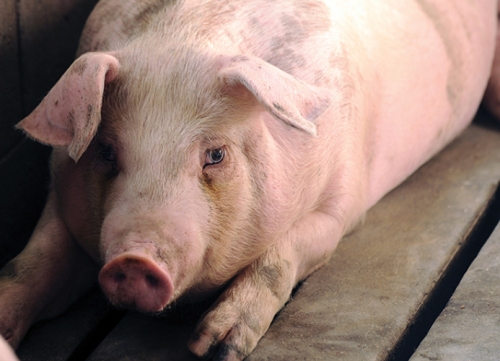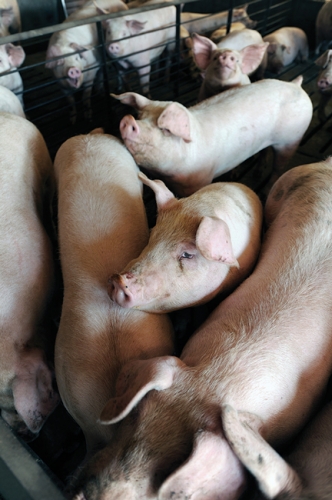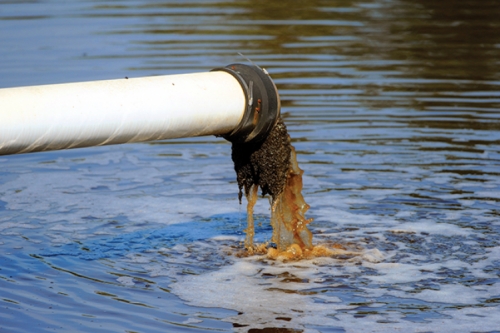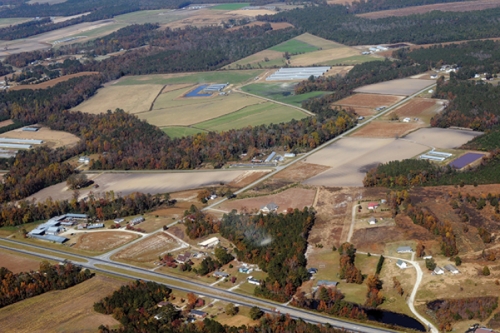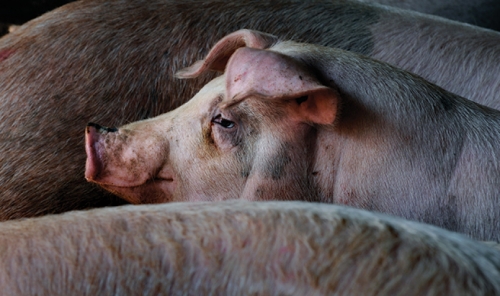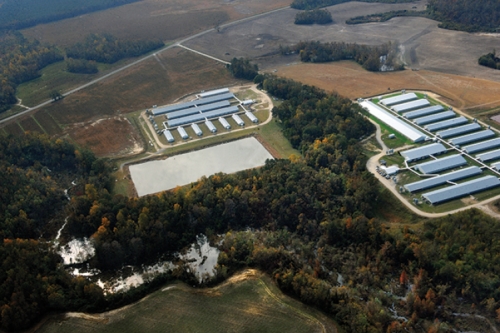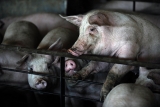Let’s say you’re a North Carolina hog farmer.
Your father grew hogs. Maybe his father did, too. Or maybe they grew tobacco, back when it was subsidized. Either way, farming’s what you know. So you’re a hog farmer.
But this isn’t your grandfather’s farm. He owned the hogs he raised; yours belong to a corporation. The corporation told you how to build your barn and how to raise the animals. It owns the feed, the trucks, the veterinary supplies.
What do you own? The waste. You have three thousand hogs, each one producing several times the waste that a human being does. You’re operating at a small margin; you don’t have the money to experiment with an expensive new waste-management system. So you do what big hog farms have been doing since the 1970s: collect the waste, flush it into an open pit, and get rid of it by spraying it on your fields.
Maybe there’s a school not far from one end of your property. Or maybe a well, or a creek that runs into the river in the next county. But your waste system was designed by engineers who said it was nondischarging, meaning that the waste and its effects stay on your land. The main thing on your mind is your contract with the corporation. It’s going to be up soon, and you need it renewed—you’ve got a twenty-year mortgage to pay off on your barn. If you can’t pay your mortgage, you’ll lose your farm.
That’s one side of the story.
Now let’s say you’re not the hog farmer; you’re a woman living in a little house nearby. Chances are you don’t have much money. Maybe your husband works on the hog farm. Maybe that’s what puts food on the table right now. If it weren’t for that farm, a lot of people you know would be out of a job.
But sometimes, when the wind is strong, you find a mist of hog waste on your windows and your car. Maybe one of your kids has asthma, and you notice that he wheezes more when you can smell the rotten-egg odor of waste in the air. Sometimes the stench is so bad it seeps into your curtains, your furniture, even your clothing. Your kids tell you they get teased at school for smelling like hog feces. You’d like to move somewhere where it’s clean and the air smells sweet, but you don’t have the money to pick up and start over. So you stay.
These are parts of the stories epidemiologist Steve Wing heard when he started visiting hog farming communities back in 1995. He’s watched as some things have changed in the seventeen years since: in 1997 the North Carolina General Assembly placed a moratorium on building hog farms that use the traditional waste pits and spraying methods, and in 2007 the moratorium became law. The state and the industry have put money into studying hog-waste management and its environmental effects.
But North Carolina still has more than twenty-four hundred hog farms, built or permitted before the moratorium, that use the waste pits. And Wing and his colleagues are still uncovering damage to human health, and to the air and water, that they say can be traced back to the waste.
For Wing, it started with a phone call from the Concerned Citizens of Tillery in Halifax County. Help, they said. We know there are problems with the farms here, but without scientific evidence, no one can do anything about it.
His first response: “What’s wrong with hog farming?” Wing lived in Chatham County. He knew people who raised hogs—small farms with twenty or a hundred head.
Come and find out, the people in Halifax County told him. So he went, and what he thought he knew about hog farming was upended. He heard the stories of corporations driving out independent farmers. Waste that doesn’t just smell bad, but drifts on the air into homes and schools. People who are too afraid of the hog industry’s influence, or of losing their jobs, to speak up.
He learned how the traditional hog-waste management system works. The floors of the barns are grated; waste drops into a trough and is then flushed into a pit covering several acres or more. The pit, called a lagoon, is usually open to the air, and it’s full of waste much more concentrated than what you’d find at a city sewage plant, with higher levels of bacteria such as fecal coliforms and Salmonella. The waste also contains antibiotics the hogs were given—often the same kinds of antibiotics used to treat human disease.
The liquid waste sits in the lagoon for six months, and then it’s sprayed onto fields where commercial crops and other plants take up nitrogen and phosphorus from the waste. The idea is for the farm to use up all the waste it produces.
One of the things Wing saw that hit him hardest wasn’t pollution: it was a map. “It was at a black church,” he says, “and they had a county map with red pins for the swine operations, green pins for the black schools, and yellow pins for the black churches.” The group was trying to show that the farms had been built disproportionately in places where black people lived.
Wing put together census data from the areas around all of North Carolina’s twenty-four hundred hog farms with waste lagoons. He found that yes, the areas of the state that are the least white—and that have the most poverty—are the areas that have the most hog farming. Also, hog farms are concentrated in places where people depend on wells for their drinking water. (We’ll come back to the water later.)
The next thing that people Wing talked to wanted to know was whether air pollution from the farms was causing some of their health problems. Wing’s team and his community partners planned a survey of people around four sites: a big hog farm, two cattle operations, and a rural area that didn’t have any large livestock operations. The researchers went to fifty homes within two miles of each of the farms and asked about symptoms that are often caused by air pollution—headaches, burning eyes, coughing. They also asked about symptoms that aren’t typically related to air pollution, such as blurred vision and hearing problems. The researchers who did the interviews were accompanied by local people contracted to work on the study, Wing says, so residents were usually willing to talk to them.
The results backed up what anecdotes had suggested: people near the hog farm reported more symptoms than did people near cattle farms or away from big farming. And the symptoms they reported were the ones related to air pollution.
The study strongly suggested there was a problem with the air, Wing says, but he wanted to do something no one else had tried yet: track pollutants in air near the farms while tracking symptoms at the same time. In this study, residents in sixteen hog-farming communities measured their lung function twice a day with personal respiratory monitors. Wing and his team found that three things were happening at the same time: respiratory symptoms, decreased lung function, and pollutants such as fine particles present in the air.
Now the researchers are doing the same kind of study in schools. In the past, they’ve found more reports of asthma symptoms from middle school students in schools where staff report smelling hog odors inside more than twice per month. So the researchers decided to investigate air quality and respiratory symptoms in schools close to hog farms.
It isn’t as unusual as you might think for a school to be near a big livestock operation, says land-use researcher David Salvesen. He and his collaborators have identified 79 North Carolina schools within one mile of big hog farms, and another 179 within two miles. In some cases the schools were built and the farms moved in later, he says, but in others the farms were actually there first.
“In some states you can’t build a school close to a waste site,” Salvesen says, “but North Carolina’s Department of Public Instruction doesn’t say anything about that. So school boards make these decisions without any guidance.” Often they choose sites away from town, so schools can have more land, he says—more space means more buildings, more sports teams, more athletic fields. These are the same rural areas where you’ll find the big farms.
This would be okay if hog farms were keeping all of their own waste like they’re supposed to. But waste pollutants are getting into more than just the air.
When Hurricane Floyd hit North Carolina in 1999, it flooded much of the eastern part of the state. The N.C. Department of Environment and Natural Resources reported that lagoons at forty-five hog farms overflowed during the flooding. But when Wing and two of his colleagues took satellite images of the flooded areas and overlaid them with a map of the state’s hog farms, they found that more than two hundred other farms were in flooded areas.
That means that many more lagoons than were reported probably flooded, Wing says, and many barns with waste in them certainly flooded. By his analysis, more than half the households near farms in the flooded areas depended on well water. There was nothing to protect those wells from contamination if waste made it into the groundwater during the flood.
Floyd caused the worst flooding in North Carolina in five hundred years; the whole state, including the hog industry, was caught unprepared. But the rules for how much room farmers are supposed to leave in their waste lagoons are based on the heaviest rainfall scientists predict will occur in twenty-five years (up to nine inches of rain in twenty-four hours). This means that if a lagoon is in operation for more than twenty-five years, chances are high that it will encounter a storm it wasn’t designed to handle. And that’s if the farmer, whose operation is inspected by the Division of Water Quality once a year, is playing by the rules.
Floyd was the last of several major problems the North Carolina hog industry had in the 1990s with breached lagoons, contaminated waterways, and nutrients from waste stimulating fish-killing algae growth. This led N.C. Attorney General Mike Easley, then campaigning to be governor, to make a deal with North Carolina’s biggest hog producers to replace the lagoon system with environmentally superior technologies. Smithfield Foods, the largest producer, by then had contracts with more than twelve hundred North Carolina farmers. The company promised to give the farmers money to convert to the new waste-management system.
The agreement sounded good—except that no one knew what that new waste-management system would be. Under the agreement, Smithfield funded research led by NC State University to find a good replacement for open lagoons and spray fields: something that would control odor, deal with nutrients such as nitrogen and phosphorus, and kill pathogens in the waste. The lead researcher asked Mark Sobsey, a water quality expert at Carolina, to evaluate how well waste-management systems disposed of bacteria.
He and his collaborators found that the standard treatment—holding hog waste in a pit for six months—reduces the percentage of bacteria in waste by 90 to 99 percent. That sounds impressive, Sobsey says, but the concentration in the raw waste to begin with is up to a hundred million bacteria per quarter cup. “If you bring that down 99 percent,” he says, “it’s still several hundred thousand bacteria or more.” Compare that to human waste, diluted with water and processed in a sewage treatment plant: it might end up with a few hundred bacteria in a quarter cup.
In theory, hog waste stays on the land where it’s sprayed; in practice, Sobsey says, waste runs off into streams during rain. When Sobsey tests waterways and groundwater adjacent to hog farms, he finds higher-than-normal levels of E. coli and other bacteria. He’s found unusual amounts of bacteria in the air downwind of hog farms, too, that he says escape into the open air when barns are ventilated.
It’s not just the numbers of bacteria that concern Sobsey; it’s the fact that these bacteria come from hogs that have been fed antibiotics that make the hogs grow faster. He’s found antibiotic-resistant E. coli in groundwater on swine farms. These strains sometimes turn up on crop farms, too, but in much lower numbers.
Sobsey and his colleagues studied different waste-management systems—constructed wetlands, biofiltration, even a composting system that grows fly larvae for livestock feed—and found that several of the systems did much better than the lagoons at everything: controlling odor, recycling nutrients, killing pathogens. The best system overall, called Super Soil, separates waste into solids for fertilizer and liquid for irrigation and reuse in hog farms.
Super Soil works well, but so far it’s been judged too expensive to fulfill the terms of the deal between the state attorney general and Smithfield. The designer of Super Soil is still working to bring down the cost, says School of Government professor Richard Whisnant, who led the committee to evaluate the economic impact of the technologies. If the system could be installed and maintained on most farms for a price that the North Carolina hog industry could recover from, the Smithfield Agreement might still be fulfilled.
Meanwhile, the N.C. General Assembly has outlawed new lagoons, saying that newly built farms, however they handle waste, will need to be more environmentally sound. But these standards don’t apply to the old lagoons—some of which aren’t even as old as the moratorium.
In 1997, North Carolina was home to about eight million hogs. Today, there are nine million. The industry has been able to keep growing in part by continuing to build on land that was bought and permitted before the lagoon moratorium took effect.
Hog farming now makes up almost a quarter of North Carolina’s agricultural income. The old methods of waste management are deeply entrenched. Progress on cleaning up the industry seems to be at a standstill, but Sobsey is still publishing new research. “We know that bacteria are getting off the farms,” he says, “but we don’t know yet how far they go, and exactly what the risks are.”
He did a pilot study several years ago that showed that people who work on hog farms have more antibiotic-resistant bacteria in their digestive systems than people who work on crop farms. He hasn’t been able to find money to follow up that study. Research on bacteria in livestock waste doesn’t fit neatly into the aims of any major funding agency, he says. If he were just looking at problems on the farms, he’d go to the USDA or the FDA. If the research was all off the farms, he’d go to the EPA. But he’s working in a gray area in between. There’s no federal funding agency devoted to problems that affect the entire water cycle.
Steve Wing is helping start up a study of water in hog farming communities with microbiologist Jill Stewart, who tracks bacteria back to their source by examining their genetic codes. The Concerned Citizens of Tillery and other groups working with Wing are worried about their wells, many of which are shallow and susceptible to groundwater pollution.
And the hog farmer stuck with a mortgage? He may not even be in business anymore. Twenty-five years ago there were fifteen thousand N.C. farms keeping hogs; now there are about three thousand. Most of those are contractors for Smithfield Foods; a few are still independents. Some are using alternative waste-management systems. Many are struggling to survive. All the farmers are left not knowing when tougher regulation will come, or who will absorb the costs if it does.
Steve Wing is an associate professor of epidemiology, Mark Sobsey is a Kenan Distinguished Professor of Environmental Sciences and Engineering, and Jill Stewart is an assistant professor of environmental sciences and engineering, all in the Gillings School of Global Public Health. Wing’s research was funded by the National Institute of Environmental Health Sciences and the N.C. Department of Health and Human Services. David Salvesen is a member of UNC’s Institute for the Environment. Richard Whisnant is a professor of public law and government in the School of Government, and the former general counsel for the N.C. Department of Environment and Natural Resources.

